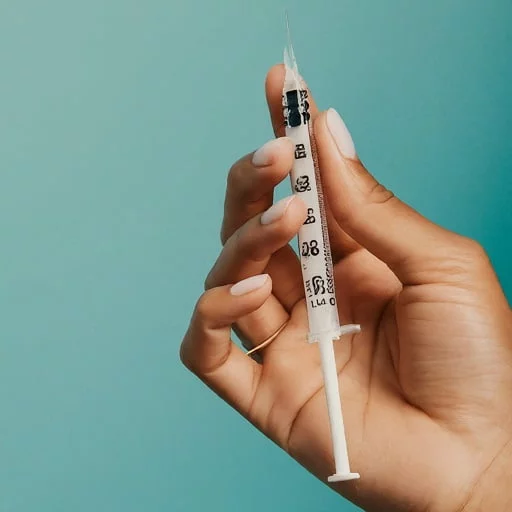Reading an insulin syringe accurately is essential for safely managing insulin doses. With different syringe sizes and unit markings, it can be tricky to get it right, especially if you’re new to syringes or switching between brands. This guide covers the basics of insulin syringe measurements, with clear, step-by-step instructions on reading them, along with answers to common questions to help you measure and administer insulin with confidence.

1. 📏 Insulin Syringe Basics and Measurements
An insulin syringe is specially marked for accurate insulin dosing. Here’s a breakdown of how to interpret these measurements.
- Unit Markings: Insulin syringes typically come in U-100 units, meaning each mL holds 100 units of insulin.
- Size Variations: Common syringe sizes include 0.3 mL, 0.5 mL, and 1 mL, with markings for specific unit increments.
- Small Doses: Smaller syringes (0.3 mL or 0.5 mL) offer finer increments, ideal for low doses.
Knowing the measurement type (mL or units) and syringe size is essential for accurate dosing.
2. 🔍 How to Read a 0.5 mL Syringe
The 0.5 mL syringe is a popular choice for those who require smaller doses. Here’s how to read it:
- Total Capacity: A 0.5 mL syringe can hold up to 50 units of U-100 insulin.
- Increments: These syringes are typically marked in 1-unit or 2-unit increments, with each small line representing a unit.
To read it accurately, align the top edge of the plunger with the marking that corresponds to your dose. For example, if you need 25 units, move the plunger to the 25-unit line.
3. 🧪 Understanding U-100 Insulin Syringe Markings
A U-100 syringe is designed for insulin with a concentration of 100 units per mL. Here’s what you need to know:
- 1 mL Syringe: Holds 100 units of insulin.
- 0.5 mL Syringe: Holds 50 units of insulin.
- 0.3 mL Syringe: Holds 30 units of insulin.
Each of these syringes has markings to help you measure insulin units accurately. For instance, a 0.25 mL dose on a U-100 syringe equals 25 units, and a 0.1 mL dose is 10 units.
4. 🔄 Insulin Units to mL Conversion: Key Measurements
Understanding how to convert units to mL is helpful, especially when you have specific dosage requirements. Here are some quick conversions for U-100 syringes:
| Insulin Units | mL Equivalent |
|---|---|
| 10 units | 0.1 mL |
| 25 units | 0.25 mL |
| 50 units | 0.5 mL |
| 100 units | 1 mL |
If you need 0.1 mL of insulin, draw up to the 10-unit mark on a U-100 syringe. For 0.5 mL, draw to the 50-unit mark.
5. 📏 Step-by-Step Guide to Reading Syringe Lines
1️⃣ Identify Your Insulin Concentration
- Ensure you’re using a U-100 insulin syringe, as it’s the most common in the USA. U-100 means there are 100 units of insulin per 1 mL, which is essential for accurate dosing.
2️⃣ Choose the Right Syringe Size
- Pick a syringe that matches your dose. If you need a smaller dose, a 0.3 mL or 0.5 mL syringe can offer more precise readings compared to a 1 mL syringe.
3️⃣ Understand the Increment Markings
- Look closely at the barrel of the syringe. For a 0.5 mL syringe, each line usually represents 1 or 2 units, while a 1 mL syringe typically shows 2-unit increments. Double-check the markings if you’re unsure.
4️⃣ Locate the Correct Dose Line
- Find the line on the syringe that represents your prescribed dose. For example, for a dose of 10 units, align with the 10-unit marking.
5️⃣ Draw the Insulin Slowly
- Insert the needle into the insulin vial and pull the plunger back slowly. This helps prevent air bubbles from entering the syringe, which can alter the dose.
6️⃣ Check for Air Bubbles
- After drawing the insulin, tap the syringe gently to move any air bubbles to the top, then push the plunger slightly to release them.
7️⃣ Recheck the Plunger Position
- Ensure the top of the plunger lines up exactly with the correct dose marking. Even a small misalignment can lead to inaccurate dosing.
8️⃣ Use Good Lighting
- To see the syringe markings clearly, read your syringe under bright light. Dim lighting can make it difficult to distinguish unit markings, especially on smaller syringes.
9️⃣ Hold the Syringe at Eye Level
- Look directly at the syringe at eye level to confirm the dose. Tilting the syringe or looking from an angle can make it harder to see the markings accurately.
🔟 Double-Check the Dose Before Injecting
- Finally, review your dose one last time. Ensuring you have the right amount of insulin loaded will help avoid dosing errors.
6. 💡 Frequently Asked Questions (FAQs)
Each line on the insulin syringe barrel represents specific unit increments (typically 1 or 2 units). To read it, align the top of the plunger with the correct line corresponding to your insulin dose.
On a U-100 syringe, 0.25 mL equals 25 units of insulin. If your syringe holds up to 1 mL, locate the 25-unit mark.
For U-100 insulin syringes, 1 mL equals 100 units of insulin. Use a 1 mL syringe for larger doses.
In a U-100 syringe, 0.1 mL is equivalent to 10 units. Locate the 10-unit marking to measure this dose.
If you’re using U-100 insulin, calculate 0.1 mL as 10 units. Adjust the plunger to the 10-unit mark on the syringe.
On a U-100 insulin syringe, 0.5 mL equals 50 units. Align the plunger with the 50-unit line for this dose.
To convert units to mL, divide the units by 100. For example, 50 units equals 0.5 mL (50 ÷ 100 = 0.5).
1 mL of U-100 insulin contains 100 units of insulin.
On a U-100 syringe, 0.5 mL corresponds to the 50-unit mark.
For U-100 insulin, 0.1 mL equals 10 units.
“20 units” is relative and depends on individual dosage needs. Always consult with your healthcare provider regarding what’s right for you.
A 1 mL syringe can hold up to 100 units of insulin. Use this syringe for larger doses by drawing up to the appropriate unit marking.
🏆 Conclusion: Confidently Reading Insulin Syringes
Understanding how to read an insulin syringe can make managing diabetes more straightforward. From knowing syringe sizes to converting units to mL, this guide should help you navigate each step of the process. The more familiar you become with your syringe, the easier it will be to ensure accurate dosing each time. 😊
Trusted Sources:
- Defy Medical provides an extensive guide on reading insulin syringes, explaining the importance of understanding both milliliters and units for proper dosage. They detail the types of insulin syringes, syringe sizes, needle gauges, and lengths and offer tips on calculating dosages and choosing the right syringe for your needs (Defy Medical).
- 4AllFamily focuses on the different types of insulin syringes available, such as U-100 and U-40, and emphasizes the importance of matching the syringe type to the insulin concentration to avoid dosing errors. The article explains how to read the units on an insulin syringe and the significance of needle gauge and length for effective diabetes management (4AllFamily).
- Insulin Outlet discusses the various sizes and types of insulin syringes, highlighting the importance of choosing the right syringe size based on the insulin dosage required. It also covers the different needle gauges used and the need to ensure the syringe concentration matches the insulin type to avoid incorrect dosing (Insulin Outlet).
- Ramon Landia offers a step-by-step guide on how to read insulin syringe units, ensuring precise dosing accurately. The guide includes tips on reading the graduations on the syringe, the importance of proper lighting and technique, and common mistakes to avoid when using an insulin syringe (Ramon Landia).
- Healthline explains the sizing of insulin syringes and how to choose the right one based on the insulin dose. This article provides practical information on the different sizes available and how they correspond to the units of insulin, helping users make informed choices about their insulin delivery (Defy Medical).





